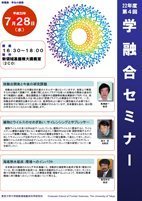AY2010 4th Gakuyugo Seminar
- Date&Time:
- Jul 28, 2010 16:30~18:00
- Venue:
- Large Lecture Room (2C0), New Frontier Science Bldg.

Fusion development and future research issues
Professor Yuichi Takase
In nature, nuclear fusion is the energy source for the sun and other stars, but it is extremely difficult to realize on earth. The development of nuclear fusion using plasma confined by a magnetic field has progressed dramatically over the past 50 years, and the International Thermonuclear Experimental Reactor (ITER), which is currently under construction through international cooperation, will conduct experiments with "burning plasma," in which the fusion power exceeds the external heating input by one order of magnitude. On the other hand, in order to increase the feasibility of fusion reactors, it is necessary to improve their performance, which will lead to increased economic efficiency, and experiments using "spherical tokamaks" are being conducted at the Graduate School. In this lecture, the future prospects of the fusion reactor will be explained in an easy-to-understand manner for students in other fields.

The struggle between plants and viruses; silencing and suppressors
Associate Professor Takumi Suzuki
Most plant viruses have RNA as their genome. When a plant is infected with a virus, a silencing mechanism that degrades and translationally represses the target RNA via double-stranded RNA produced during the replication of the viral genome is triggered, thereby suppressing the proliferation of viral RNA. On the other hand, viruses have evolved to acquire suppressor proteins that interfere with silencing in response. Furthermore, among plant viruses, those with DNA as their genome also have suppressors of silencing. I would like to introduce some of the research on suppressor proteins of these plant viruses.

Submarine hydrothermal deposits: environmental impact
Professor Yukichi Iizasa
Many active submarine hydrothermal deposits have been reported not only in the sea area around Japan but also in the Central Ridge. In many of these hydrothermal deposits, there are numerous active chimneys, from which various materials are released. By grasping and understanding this reality, we will consider how to reduce the environmental impact of future commercial development.
*The contents of this page were developed based on a machine translation.

